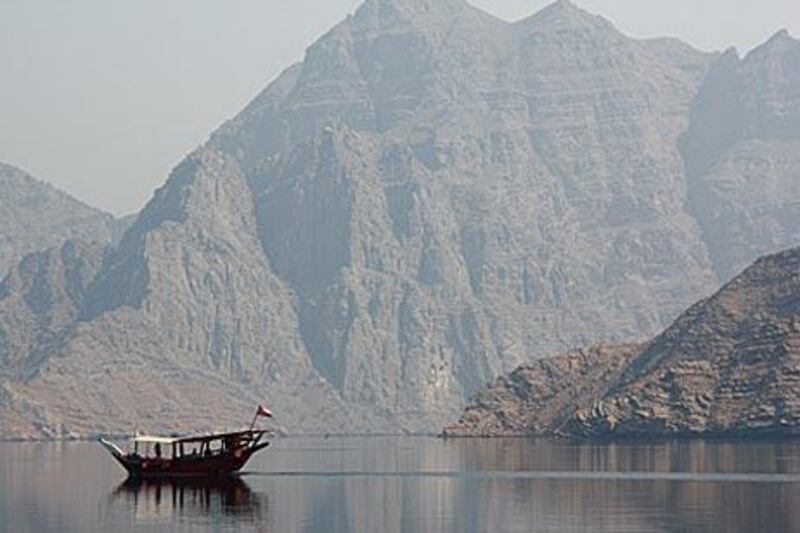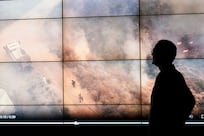The seas around Oman's Musandam peninsula are home to spectacular but fragile coral reefs. Homa Khaleeli joins a diving expedition to help to protect this sublime underwater world. Freefalling through the clear water, I realised I had made a terrible mistake. When I signed up to take part in a diving expedition off Oman's Musandam peninsula I had neglected to remember one thing; I couldn't really dive. Sure, I had the Padi open-water diving certificate that was the requirement for the expedition, but I got that almost a decade ago on a trip to Thailand and had long since forgotten the practical skills I learnt. Now, surrounded by enthusiasts with hundreds of dives in exotic locations under their weight belts, I was regretting my optimism; one refresher course in my local swimming pool had obviously not been enough to bring me up to speed. Yet despite my misgivings the opportunity had been too tempting to ignore - Biosphere Expeditions, a not-for-profit organisation specialising in adventurous conservation vacations, was for the first time taking divers to the breathtaking fjords of Musandam. Our base would be a dhow cruising the Arabian Gulf and Gulf of Oman and our task would be to help to protect the peninsula's spectacular coral reefs. So far, everything had gone well. Arriving on a small, prop-driven light aircraft from Oman's capital, Muscat, I had joined my fellow volunteers on board the dhow, sailing out from Khasab harbour. Among the group were divers from the US, Brazil, Germany, the UK and the UAE - as well as the team's marine biologist, the glamorous and enthusiastic Rita Bento. Leading us was Matthias Hammer, a former soldier in Germany's parachute regiment and biologist, international rower, survival expert and head of Biosphere Expeditions. Matthias explained that in Musandam our group would be taking part in Reef Check, an international reef-monitoring scheme that allows scientists to compare the state of these complex eco-systems around the world. But before we could start on the survey we would have to be trained - taking exams in fish, invertebrate and coral recognition - and prove we could dive without damaging the reefs we had come to protect.
Which was when my problems started. Trying to assemble the various tubes, gauges and safety clips made me realise just how much I had forgotten. In a panic, I confessed my inexperience to Rita. Luckily the group was sweetly encouraging. Rita immediately put me under the care of Connie, a certified dive instructor who gave me some much needed one-to-one tuition. As I flailed through the water for the first time I wasn't sure I should have come, but when I saw the reef itself I knew I had made the right decision. Dipping under the water was to enter a world in Technicolor. I spotted a combative lionfish displaying its stripes and psychedelic parrotfish grazing on coral. Floating past rocks studded with black, spiky urchins were huge Arabian angelfish. And of course the corals themselves were beautiful - intricate structures in primary colours. Discovering that such beauty is under threat would be enough to turn anyone into an eco-warrior and back on board the dhow Rita explained that reefs were disappearing at a terrifying rate around the world. Coral is home to 33 per cent of the world's fish and generates income for more than 20 million people. Too few of us understand that it is not a plant or rock, but made up of tiny living organisms, called polyps, which are frighteningly easy to kill. Swimmers who touch it, the anchors of boats, litter, global warming, deep-sea trawlers and disease - all can damage the reef. Some scientists say rising acidity levels in the sea, caused by increased carbon dioxide in the atmosphere, may lead to the disintegration of more than 9,000 of the world's reefs in the next 100 years. In Musandam, the peninsula's status as a sleepy backwater seems to have protected the reef. Commercial fishing, for instance, is banned, although the illegal spearfishing that takes place can be harmful. Tourism in the area is still low-key although I heard stories of local boats taking visitors to swim and even walk on the reef without explaining the dangers. A recent cyclone and algae bloom have also affected the health of the Musandam reef, according to Rita.
The key to protecting the coral in Oman is gathering accurate information about the threats it is facing and that was why we were there, as part of Reef Check. Covering as many areas of the peninsula's reef as possible, our group would dive to collect specific data; this would be analysed by Rita who would produce a report for local conservation groups, outlining exactly what protection the reef needed. To do this, we had first to learn what "indicator species" to look for - the fish and creatures that would show the state of health of the underwater ecosystem - and so for the first three days we joined Rita at 7am for lessons on how to distinguish between a grouper fish (grumpy-looking) and sweetlips (they pout like Angelina Jolie); just as important are the invertebrates, such as the crown of thorns starfish and the vicious-looking moray eels. Next came classes about the coral itself - how to distinguish between hard and soft coral, coral bleached by high temperatures and coral killed by disease. In the afternoons Rita set us underwater tasks, from playing "rock, paper, scissors" to passing weights between us, designed to assess and improve our buoyancy control to ensure we would not bump into the coral. By this time I was so terrified of harming the reef that I kept bobbing to the surface like a helium balloon in a wetsuit. Despite the hard work, the trip was far from a hair-shirt experience. In the evenings there was time to lounge on the carpets and cushions that covered the dhow's decks and enjoy the delicious food prepared by the Keralite cook, Polly, before retiring to our tiny but cool and comfortable cabins, some of which were en-suite. And then there was the landscape itself. This exclave of Oman is known for its austere beauty. Endless limestone cliffs, unrelieved by vegetation, plunge straight into the sea below. Stretching out into the Strait of Hormuz, the peninsula is close enough to Iran to spot the small boats of smugglers shuttling back and forth, weighed down with goats and cigarettes. Yet as the dhow steered through the fjord-like channels, only a few fishing villages interrupted the sense of isolation.
The balmy temperature of Oman and the silence of the surrounding limestone crags tempted almost everyone to bunk down on the decks; although the days were tiring, waking in the gentle dawn after a night under the stars was as refreshing and removed from real life as any holiday spent lounging on a beach. My fellow volunteers were a fascinating mix of keen divers and general adventurers and helped to make the trip a laid-back experience. Any down-time was taken up with tall tales of diving with giant squids and sharks or, for the more energetic, scuba-less "free-diving" classes from Adil, a volunteer from the UAE. With his mono-fin and a lungful of air he could reach greater depths than I ever could with my oxygen tank. Thanks to the support of the group, by the time we were ready to start the Reef Check I was at least competent enough to help to lay a tape along the seabed, marking off the section of reef the group would be investigating. The volunteers swam slowly along it in pairs, noting the species they saw, though it took practice to learn to move carefully enough to be able to count the fish and sea creatures. To ensure as much of the reef as possible was surveyed, the group made three dives a day for the final three days. As I swam near by, watching the volunteers dangling upside down as they checked under rocks for lobsters or banded coral shrimps, or move in slow motion as they tried not to startle the snub-nose butterfly fish, it was dizzying to see the teeming life of the reef - and thrilling to be able to name the fish I saw. For the first time, I noticed how some coral would "flicker", when the tiny polyps sensed my presence and retracted; when I found myself caught up in a silver stream of fusiliers I could only wonder at the beauty of the underwater world. I felt like I was in a scene from Avatar.
After the trip was over and we had all returned home, Rita and Matthias kept us updated with the results of our Reef Check and those of other groups they had taken to Musandam. The Reef Check survey will need to continue for several years before a clear picture of the state of the reef can be built up, but even our set of findings showed there were some signs of damage caused by boats, often by anchors, rubbish and old fishing nets. On the plus side there was little coral bleaching or sign of disease although, said Rita, with recurrent oil spills in the region and water temperatures rising, the reef would need to continue to be monitored. We had also confirmed the presence of damsel fish, angel fish, sea breams and emperor fish, as well as lots of snappers and diadem urchins, but Rita feared the low number of sweetlips might be a sign of overfishing, although this cannot be confirmed until next year's surveys. Overall, the result was an encouraging one. There was still a lot of coral in Musandam - and, with plentiful nearby rocks, there are even more places for it to grow and thrive. Learning and swimming on the reef was an unforgettable experience. And while I may not have been the most competent eco-warrior, I am still proud of the tiny part I played in trying to keep this ecosystem safe. travel@thenational.ae
Thanks to the dive surveys carried out by its clients in 2009, Biosphere Expeditions has now accumulated enough data to press ahead with its goal of having Musandam's coral reefs designated as a Marine Protected Area (MPA), a UNESCO Biosphere Reserve and, perhaps, even as a World Heritage Site. "This will take time and some significant support at government and other levels, but we have made a start," said Matthias Hammer, head of Biosphere Expeditions, in an email circulating its 2009 project report and thanking all the divers who had taken part in its Reef Check surveys. Last year's survey, conducted at 18 sites dived between October 18 and 31, found larger populations of butterfly fish and snappers than of sweetlips and parrotfish, though the concentration of snappers was far greater than typical in the Indo-Pacific region. However, numbers of groupers, a popular catch for fishermen, were notably low. Not all abundance is welcome; in the survey of invertebrates, the discovery that the number of diadema urchins was significantly higher than average was a cause for concern, as its presence "increases bioerosion activity in the area, making new coral recruitment difficult". On the other hand, the mean hard coral coverage of 34 per cent identified by the survey is better than the worldwide calculated coverage of 30 per cent. Further Reef Check surveys, together with studies of fish catches, should be carried out to address concerns in more details, says Biosphere Expeditions, a partner of the UN Year of Biodiversity 2010. The designation of a Marine Protected Area, or a network of MPAs, "would also help to overcome the principal problems encountered, such as the lack of available data on natural resources, the absence of proper fixed and marked mooring buoys and low public awareness". Declaring the Musandam peninsula a UNESCO Biosphere Reserve and, eventually, a World Heritage Site, "is something that should be considered at a government level".





